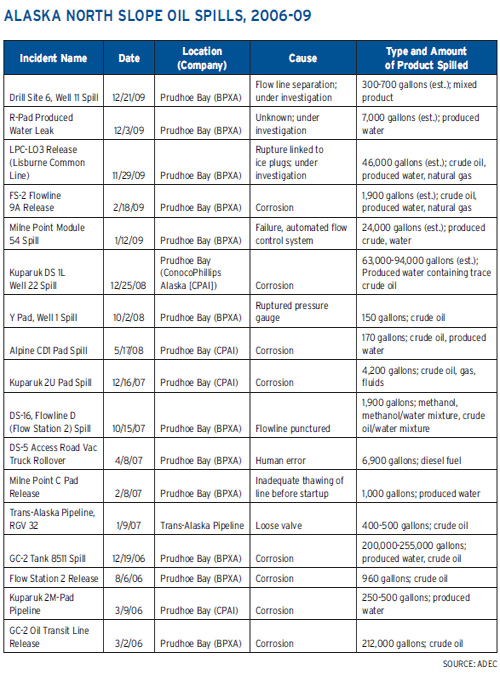Alaska Spills Highlight Ever-Present Risks from Oil Industry
Alaska's oil and gas industry has experienced several high-profile oil spills over the past few months, highlighting the risk associated with oil and gas exploration and production, pipeline operation and vessel activity. Harsh arctic winter conditions have played a part in causing some incidents, delaying the detection of others and slowing the response and cleanup in some cases.
- Between 2006 and 2009, nearly 660,000 gallons of oil, natural gas and wastewater was spilled on the North Slope.
- Since 2006, three to six significant spills have occurred annually on the North Slope
A review of North Slope oil spills from 2006 to 2009 shows that three to six major spills a year are the norm. The total amount of oil, natural gas and wastewater—all harmful to Arctic tundra—spilled on the North Slope during those years is estimated at nearly 660,000 gallons. Even more oil is spilled from oil and gas exploration, vessel operations and pipelines in other parts of the state.
December 2009: Leaking well line and grounded tugboat pour oil, diesel into Alaska waters
On Dec. 21, 2009, a six-inch well line carrying a mixture of crude oil, natural gas and produced (highsalinity) water separated and leaked an estimated 300 to 700 gallons. The spill occurred in Prudhoe Bay on Alaska's North Slope, at a BP exploration well that was shut in at the time. Investigation into the cause is ongoing, and the actual spill volume is still unknown.
Two days later, the tug Pathfinder, which had been sent to Prince William Sound to scout for icebergs in the shipping lanes, ran aground on the wellmarked Bligh Reef, where the Exxon Valdez tanker ran aground in 1989, unleashing one of the biggest environmental disasters in U.S. history. The reef tore a five-foot gash in the Pathfinder's hull, spilling an unknown quantity of diesel fuel.
November 2009: BP pipeline rupture in Prudhoe Bay spills 46,000 gallons
On Nov. 29, 2009, a pipeline associated with BP's Lisburne Production Center in Prudhoe Bay on Alaska's North Slope ruptured, causing a major spill of crude oil, produced water and natural gas. An estimated 46,000 gallons spilled from a two-foot gash in the pipeline, probably caused by ice plugs within the line that allowed pressure to build to unsafe levels. The spill contaminated 8,400 square feet of snowcovered tundra, requiring manual and mechanical cleanup, including construction of an ice road for vehicles to access the spill site; jackhammers to remove frozen, contaminated snow and ice from around the pipeline; and melting the frozen waste so the oil and water could be separated, stored and disposed of.
North Slope operations typically result in several spills a year, the worst in 2006.
Unfortunately, 2009 was not the exception for North Slope oil production-related spills; it was the norm. Since 2006, three to six significant spills have occurred annually, including the largest North Slope oil spill to date in 2006.












